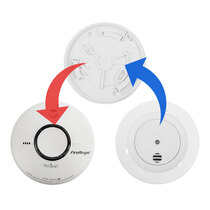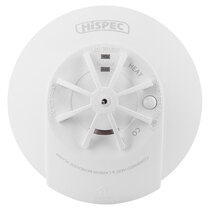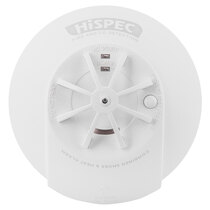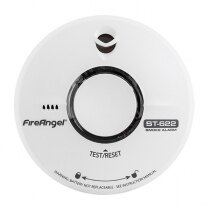-
Contact
Sales & Customer Service
0800 612 6537 support@safelincs.co.uk Live ChatDelivery Enquiries
0800 077 6149 - Resources
Fire & Safety Solutions
CALL OUR TEAM NOW 0800 612 6537
Lines open today 8am - 6pm
FREE Delivery
on marked products
Live Chat - Online
Instant help & Advice
Trade Discounts
and exclusive pricing
0% Credit Available
Open an account now
5 Star Customer Feedback
Combined Alarms with Multiple Sensors
Comprehensive detection technology combines multiple sensing methods in single units. These smoke and carbon monoxide alarms provide protection against both fire and toxic gas hazards, streamlining installation and maximising safety coverage. Combined Detection Capabilities Dual-sensor technology incorporates both photoelectric smoke detection and electrochemical CO sensing in one compact unit. This combination addresses the two most common domestic safety threats through efficient, space-saving design. Advanced processing algorithms coordinate between different sensors to minimise false alarms and maintain high sensitivity to genuine threats. These intelligent systems distinguish between hazardous conditions and normal environmental variations. Some models incorporate heat sensing alongside smoke and CO detection, creating triple-threat protection in a single device. This comprehensive approach suits areas where multiple fire types might occur. Visual or audible indicators display the specific hazard detected, helping occupants understand the nature of the threat and respond appropriately. Different LED colours or patterns indicate smoke, CO or heat detection, or voice alerts signal the presence of fire or CO. Carbon Monoxide Protection Invisible and odourless, CO poses severe health risks that smoke alarms cannot detect. Faulty heating systems, blocked flues, and inadequate ventilation can create dangerous CO concentrations without obvious warning signs. Early CO detection prevents poisoning incidents that claim lives annually. Symptoms like headaches, dizziness, and nausea may be mistakenly attributed to other causes, making reliable detection equipment essential. Electrochemical sensors provide accurate CO measurement across relevant concentration ranges. These sensors maintain sensitivity throughout their operational lifespan, ensuring consistent protection against toxic gas accumulation. Battery-powered CO detection offers flexibility for placement near potential sources. Boiler rooms, garages with attached living spaces, and areas with fuel-burning appliances benefit from dedicated monitoring. Installation Strategy Bedrooms benefit from combined detectors that address both fire and CO risks. These areas require protection against smouldering fires and also monitoring for CO intrusion from adjacent utility areas or attached garages. Open-plan living areas suit multi-sensor protection where cooking, heating, and electrical appliances create various potential hazards. Combined detection provides comprehensive coverage without cluttering ceilings and walls with multiple devices (CO detectors should be wall-mounted ideally, not ceiling-mounted). Basement installations monitor areas where both fire risks and CO sources commonly exist. Furnaces, water heaters, and stored materials create conditions where multiple detection types prove valuable. Holiday homes benefit from comprehensive protection that operates reliably during vacant periods. Multi-sensor alarms provide peace of mind knowing various threats are monitored continuously. Product Options FireAngel FA3820 combines optical smoke detection with CO monitoring in a battery-powered unit suitable for residential applications. This model provides reliable dual protection with clear hazard identification. The Hispec RF10-PRO smoke and heat alarm, with a rechargeable sealed lithium battery backup, is a mains-powered multi-sensor that ensures smoke and heat detection in one alarm. It can be installed in open kitchen-dining rooms and interlink with up to 20 compatible devices. Our combined alarm selection includes various sensor combinations and power options. Professional guidance helps you select appropriate multi-threat protection for specific applications. For comprehensive fire safety planning, consult our complete protection guides that explain how different detection technologies complement each other. Maximise protection efficiency with advanced multi-sensor technology. Explore our combined detector range and discover how comprehensive threat detection simplifies safety planning. Frequently Asked Questions (FAQs) What is the benefit of smoke and carbon monoxide alarms combined? A combined smoke and carbon monoxide alarm provides protection against both fire and toxic gas hazards in a single device, simplifying installation and ensuring comprehensive threat detection. Do multi-sensor alarms cost more than separate detectors? Multi-sensor alarms often cost less than purchasing separate smoke and CO detectors, while also reducing installation time and ceiling clutter with streamlined protection. How accurate are combined smoke and CO detectors? Modern combined detectors use advanced sensor technologies that provide accurate detection for both threats, with sophisticated processing that minimises false alarms from either detection method. Can multi-sensor alarms replace individual smoke and CO detectors? Multi-sensor alarms can effectively replace individual detectors in most applications, though specific installation requirements should be verified against relevant safety standards and regulations.
Read more about multi-sensor alarms...
Combination Carbon Monoxide and Smoke Alarm 10 Yr Warranty - Kidde K10SCO
- Product Life: 10 years
- Battery: 2 x AA alkaline battery powered (included)
- Warranty: 10 year warranty
- Combined optical smoke and carbon monoxide detector
- Ideal for hallways, bedrooms, and living rooms
- Voice alarm and sounder: different warning messages for smoke and CO
- Certified to BS EN 14604: 2005 (smoke alarm)
- Certified to BS EN 50291-1: 2018 (CO alarm for domestic use)
10 Year Longlife Battery Combination Optical Smoke and CO Alarm - FireAngel SCB10-R
- Product Lifespan: 10 years
- Battery: Built-in, lasts the life time of your product
- Warranty: 3 year warranty
- Combined optical smoke and carbon monoxide detector
- Ideal for hallways, bedrooms and living areas
- Sleep Easy™ function
- Kitemarked to EN 14604: 2005 (smoke detection)
- Kitemarked to EN 50291-1 (carbon monoxide detection)
- Suitable for ceiling installation
Mains Powered Combined Optical Smoke and Heat Alarm with Self-Charging 10 Year Back-up Battery - Aico Ei3024
- Power: 230V mains powered with lifetime back-up battery
- Backup Battery: Self-charging battery
- Warranty: 5 year warranty
- Multi-sensor alarm containing both an optical and heat sensor
- Hardwire interlink with up to 12 compatible devices
- Extract real time data to your smart phone
- Kitemarked to BS EN 14604: 2005 (smoke)
- Kitemarked to BS 5446-2: 2003 (heat)
- Also suitable for both the Welsh and Scottish 2022 legislation
Mains Radio-Interlinked Combined Smoke and Heat Alarm with Self-Charging 10 Year Back-up Battery - Aico Ei3024RF
- Power: 230V mains powered with back-up battery
- Backup Battery: Self-charging battery
- Warranty: 5 year warranty
- Combined alarm: both an optical smoke, and heat sensor
- Hybrid interlinking with up to 12 compatible devices
- AudioLINK - extract real time data to your smart phone
- Kitemarked to BS EN 14604: 2005 (smoke)
- Kitemarked to BS 5446-2: 2003 (heat)
- Also suitable for both the Welsh and Scottish 2022 legislation
Replacement for FireAngel ST-620 10 Year Smoke Alarm - UltraFire ULLS10
- Easily replace FireAngel ST-620 alarm with UltraFire ULLS10
- Adaptor plate simply twists onto existing baseplate
- Battery: 10 year sealed lithium battery
- Warranty: 10 year manufacturer's warranty
- Combined test and silence button
- Suitable for BS 5839-6: 2019 Grade F1 installations
- CE and Kitemarked to BS EN 14604: 2005
Mains Powered Heat & CO Detector with Rechargeable Lithium Battery Backup - Hispec RF10-PRO
- Power: 230V mains powered with lithium back-up battery
- Back-up Battery: Rechargeable lithium battery
- Warranty: 5 year manufacturer's warranty
- Multi-sensor alarm containing both an heat and CO sensor
- Radio-interlink up to 20 compatible alarms
- Kitemarked to BS 5446-2: 2003 (heat)
- Kitemarked to BS EN 50291-1: 2018 (carbon monoxide)
- Also suitable for both the Welsh and Scottish 2022 legislation
Mains Powered Smoke & Heat Alarm with Rechargeable Lithium Battery Backup - Hispec RF10-PRO
- Power: 230V mains powered with lithium back-up battery
- Back-up Battery: Rechargeable lithium battery
- Warranty: 5 year manufacturer's warranty
- Multi-sensor alarm containing both a smoke and heat sensor
- Radio-interlink up to 20 compatible alarms
- Kitemarked to BS EN 14604: 2005 (smoke)
- Kitemarked to BS 5446-2: 2003 (heat)
- Also suitable for both the Welsh and Scottish 2022 legislation
Combination Carbon Monoxide and Smoke Alarm 10 Yr Warranty - Kidde 10SCO
- Product Lifespan: 10 years
- Battery: 2 x AA alkaline batteries (included)
- Warranty: 10 year warranty
- Voice Alarm and Sounder: Different Warning Messages for Smoke and CO
- Kitemarked to BS EN 50291-1: 2018 (CO alarm for domestic use)
- Kitemarked to BS EN 14604: 2005 (smoke alarm)
- Suitable for ceiling installation
4.8 out of 5 stars
View Product
| 1 unit |
£21.90 inc VAT £18.25 ex VAT |
|---|---|
| 2+ units |
£21.30 inc VAT £17.75 ex VAT |
| 5+ units |
£20.10 inc VAT £16.75 ex VAT |
10 Year Thermally Enhanced Optical Smoke Alarm (Thermoptek) - FireAngel ST-622
- Battery: Built-in, lasts the lifetime of your alarm
- Warranty: 5 year warranty
- Combined smoke and heat alarm (Thermoptek)
- Test, hush and Sleep Easy™ feature
- Optical sensor less prone to false alarms
- Suitable for BS 5839-6: 2019 (Grade F1 installations)
- Kitemarked to BS EN 14604:2005
Combined Alarms with Multiple Sensors
Improving Fire & CO Detection in my Home
Combined Alarms with Multiple Sensors
Combined alarms provide additional smoke, heat, and carbon monoxide detection through multiple sensors. These combination alarms usually have different alarm sounds, especially when detecting for two different dangers such as fire and carbon monoxide (including voice alert warnings) to inform occupants of the type of danger that has been detected. Combined sensor alarms are available in a range of configurations, including:
- Optical smoke detectors with heat detection
- Optical smoke detectors with carbon monoxide (CO) detection
- Heat detectors with carbon monoxide (CO) detection
Different combined sensor alarms are best suited to different areas of the home. For example, heat and CO alarms are great for kitchens and garages, reducing false alarms from dust and steam which may trigger optical alarms, while providing carbon monoxide detection. Smoke and heat detectors are suitable for kitchen diner rooms (but not directly over the kitchen area) where no fuel burning appliance is installed, while smoke and CO alarms are suitable throughout the home, apart from in kitchens, garages, and unoccupied loft spaces.
Combination alarms are also available in battery powered and mains powered variants, with radio-interlink technology and hard-wire options. This allows combined alarms to fulfil the highest levels of home protection. If you’re struggling to find the best detector for your needs, use our handy filter system for this category page, or contact our friendly customer support team on 0800 612 6537 for further advice.
Improving Fire & CO Detection in my Home
There are lots of things you can do to improve fire safety in your house. Fitting working smoke and heat alarms throughout your home is the best way to protect your family, while testing these regularly is just as important. Installing combination alarms which includes carbon monoxide detection further protects your family from dangers within the home.
Other steps to prevent fires, amd slow the spread of fire if one does start can also keep your family safe. For example, by keeping doors shut at night, even if they are not fire doors, they will act as a barrier to slow the spread of flames throughout the home by a few minutes, increasing time for your family to safely escape. This is particularly important for doors providing access to the kitchen, as this is where fires are most likely to start.
The best way to prevent fires in the home is to be aware of fire risks, and to reduce these wherever possible. For example, homes which are particularly cluttered, have deep fat fryers, or where residents smoke have an increased fire risk. To find out more about the fire risks in your home, use our Home Fire Safety Check tool. This quick questionnaire will identify the fire risks in your home, and give personalised tips on improving fire safety.
Compare (0)
Reset



























